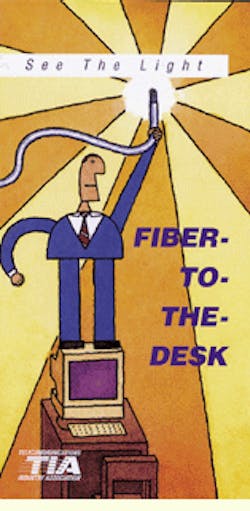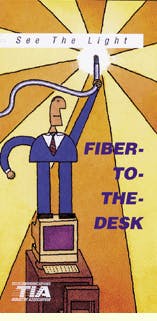TIAs fiber-optic LAN section celebrates first birthday
Arlyn S. Powell, Jr.
At the 1993 ComNet show, the Telecommunications Industry Association announced it had established a Local Area Network Section in its Fiber-optic Division to parallel the Copper LAN Section already in existence. According to TIA`s president at the time, Mike Frischkorn, the new group`s goal was to "focus on the importance of optical fiber as a critical component of our national infrastructure."
This winter, the Fiber-optic LAN Section celebrates its first birthday. During this past year, the group issued a white paper that explains its position. The LAN Section has also attended major LAN business shows during the year and is conducting seminars about the strengths of optical fiber and the unresolved questions surrounding Category 5 unshielded twisted-pair copper cabling.
Handling optical fiber
"Two years ago, contractors believed that fiber was difficult to work with," says D`Arcy Roche, president at Raylan Corp. (Palo Alto, CA) and an active member of the section, "and that it was very fragile and expensive. We`ve seen a significant improvement in understanding recently. Believe me, fiber is easier to install and less fragile than Category 5 copper."
As the word has spread that crushing, bending and stretching Category 5 UTP cabling can deform the geometry of its wire pairs and affect its high-speed performance, optical fiber cable-with a bend radius similar to that of Category 5 copper and a pulling tension that is much more robust-is being seen as less delicate and exotic. The installation training provided by a number of vendors, as well as demonstrations at trade shows, have illustrated this point. For example, at a recent show, an 11-year-old girl won the contest for putting on a fiber-optic connector in the shortest amount of time-51 seconds.
The group is also touting optical fiber as having almost unlimited information-carrying capacity. Tony Beam, premises marketing manager at Siecor Corp. (Hickory, NC), says, "It`s not a copper-versus-fiber issue. The issues are headroom and testability-and the ability of optical bandwidth not to be affected by installation. There`s nothing that the installer can do to affect the bandwidth of the fiber, and the end user can be assured of the ability to handle 155 megabits per second, 622 Mbits/sec or 1.2 gigabits per second in the future."
Copper cabling, on the other hand, faces several problems related to its headroom. Improper or sloppy installation techniques can affect copper wiring`s ability to carry high-speed data. Also, as the speed of information flow increases, properties of the wire itself and its electrical environment began to affect the signal. Near-end crosstalk and attenuation limit the transmission distance and rate, and electrically noisy environments can produce interference on nearby data cabling. In fact, at high frequencies, the data cabling can transmit signals, bringing it into conflict with Federal Communications Commission regulations. Although laboratories continue to push upward the transmitting ability of copper wire, a finite upper limit exists. What can be achieved in the laboratory can also be significantly different from the upper limits of an office or factory installation.
Fiber to the desk finds markets
Optical fiber, on the other hand, has already begun to find a number of horizontal-distribution markets because it does not suffer from the electrical problems affecting copper cable. Factory floors, for instance, are often electrically noisy environments that cannot support unshielded copper wiring, and electrical utilities and power-generating facilities have similar concerns. Schools and colleges prefer fiber for several reasons: For budgetary reasons, they want to avoid recabling; multimedia requirements are already calling for high bandwidth; and the distance between buildings in a campus environment exceeds the transmission limit of copper. Hospitals are also turning to fiber because of their real-time imaging requirements and the sensitivity of their data to noise and errors introduced by electromagnetic and radio-frequency interference.
Another area where copper wiring may find itself in trouble is in the modular furniture found in open-office environments. The need to separate power and telecommunications cabling in the built-in raceways of this furniture is being investigated.
Because it is not hampered by the 90-meter transmission limit of Category 5 copper cabling, optical fiber has opened the way for the consolidated communications closet (see "Horizontal network topologies for optical-fiber cable systems," January 1995, page 27). The concept is simple, according to Roche: "All the electronics in a building are in one closet, and you run cable from the desktop through a point of consolidation to that closet." The point of consolidation may be a traditional wiring closet, but it contains no active electronics, just a transition point from horizontal to vertical cabling.
Without decreasing the flexibility of the cabling system-because crossconnects can still be located in individual wiring closets-the consolidated closet offers several benefits. You get extra closet space, which can be compelling when you are retrofitting your installation. You cut down on active electronics by avoiding it in the individual closets. You simplify problem management because one of the trouble points of the system is removed. This also reduces the need for maintenance and troubleshooting. In addition, it is easier to transition from one network to another-for instance, from Ethernet to token ring-if all active equipment is in one room. Moves, adds and changes are simpler to make, and there is less need for expensive electronics. "When you add up these benefits, they become compelling," Roche concludes.
Facing the cost issue
The major issue for optical-fiber manufacturers, however, is cost. Installers generally agree that fiber is for backbone and copper is for horizontal cabling, and the reason is primarily one of the expense associated with each medium. Roche points out, though, that perceptions about cost are changing. He says, "We now find that the perception of the price premium is recalibrating to what we think it really is. We believe the price premium can easily get down to $35 to $50 a node." Roche claims that the work of the TIA Fiber-optic LAN Section has led to the change in perception. Also, many optical-fiber component manufacturers have recently made technological breakthroughs that have let them lower prices.
The controversy continues concerning Category 5 testing, with new discoveries and announcements made almost monthly (see "Category 5 testers revisited: What a difference a year makes," January 1995, page 6). End users are requiring certification of installed Category 5 cabling plants, even though the TIA has yet to establish testing parameters and procedures for high-speed UTP copper cabling. Test procedures for optical fiber, on the other hand, are stable and well-documented in the Fiber-optic Test Procedure series of standards. The optical characteristics of fiber are less complicated than the electrical properties of copper wire. The tests are simpler to perform, and the testers are easier to use.
The almost-daily revelations about new factors to consider when you install high-speed copper cabling have led the copper industry to adopt a new strategy, according to members of the Fiber-optic LAN Section. Many major manufacturers of structured copper wiring systems are offering long-term warranties-up to 15 or 16 years-if their systems are installed and tested by trained installers prior to acceptance by the end user.
According to Roche, "The copper industry is saying to the customer, `You still don`t have to go to fiber. We are going to give you everything that fiber gives you, and because we know you`re a little uncomfortable about it, we`re going to warrant it.` Why do you think that warranty is out there? Because the customer is suspicious."
The Fiber-optic LAN Section offers one final prophecy-Category 5 cabling will be supplanted in the near future by a still-higher category, requiring that end users who have put in Category 5 systems will have to rip them out and replace them after only a few years. There are already signs of this in the introduction by a number of vendors of so-called extended-performance Category 5 cabling. This cabling is capable of handling the 155-Mbit/sec data rate proposed for the asynchronous transfer mode standard. q
The TIA Fiber-optic LAN Section brochure promotes fiber to the desk and dispels some of the myths about copper cabling.

